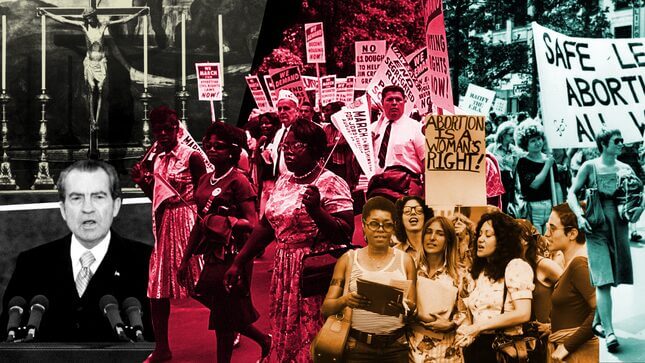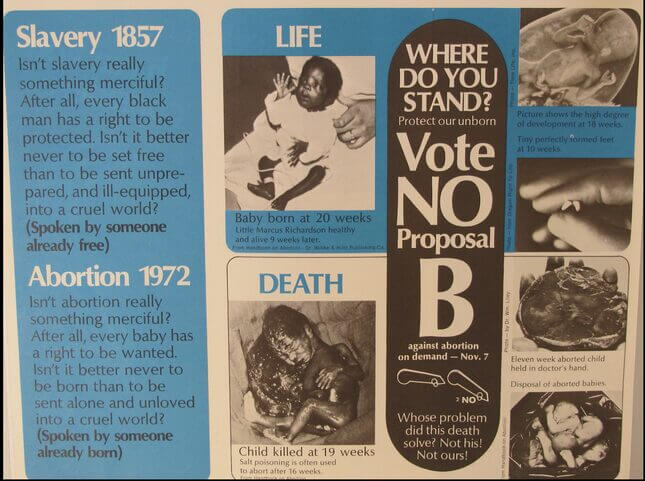The Deep Ties Between the Catholic Anti-Abortion Movement and Racial Segregation
In Depth
The video of MAGA hat-wearing Covington Catholic High School students, who were in Washington DC for the March for Life, in a tense standoff with Black Israelites and a Native American contingent from the Indigenous People’s March, has become hotly debated national news.
Though the close focus is on the immediate chain of events, it’s important to note the historical intersection of conservatism, race, and abortion that set the stage for the arrival of these white Catholic students. The modern Catholic anti-abortion movement was born in white enclaves and shaped by the politics of white flight and anti-integration activism. The sight of white Catholic teens wearing clothes emblazoned with Donald Trump’s racially inflammatory brand at the March for Life, marks a vital connection that has shaped modern conservatism and the Republican Party.
Racial politics undergirded the anti-abortion movement from the outset and continues to shape its imagery and concerns. The modern Catholic anti-abortion movement emerged in the early 1960s in response to heightened agitation by legal and medical organizations and mainline Protestant and Jewish groups for abortion law reform. Crucially, this organized anti-abortion activism was cradled and nurtured in white Catholic enclaves in and around Boston, Chicago, Cincinnati, Detroit, and New York City (among other places) and at the height of white flight. Covington Catholic High School is part of this history. The overwhelmingly white campus is mere minutes away but cordoned off from the predominantly black public schools of downtown Cincinnati.
In many instances, parishioners bucked their own religious leaders who advocated for racial justice.
After World War II, white Catholics increasingly moved from cities to suburbs. For those white working-class Catholics who didn’t leave cities, their neighborhoods often abutted African American neighborhoods. This proximity set the stage for explosive conflicts over school busing and integration of public and parochial schools. In many instances, parishioners bucked their own religious leaders who advocated for racial justice. There are newspaper reports, for example, of white parishioners heckling and shouting down nuns who sought to integrate Detroit’s Catholic schools in the early 1970s. Many other Catholics quietly and unceremoniously voted with their feet by moving deeper into all-white suburbs and exurbs. These parents espoused a colorblind logic—many disavowed racial motivations altogether—and instead emphasized the need for safer schools and neighborhoods or lower taxes. As these white Catholics migrated away from black people, the Catholic Church followed and built churches and schools in these neighborhoods. The Catholic Church, in other words, practiced and preached racial justice even while buttressing racial enclaves and de facto segregation academies.
Whether it was in cities or suburbs or through race-blind or explicitly racist logic, white Catholics resisted integration through the 1960s and 1970s. And at this very moment of racial retrenchment, abortion became increasingly important to Catholics, as well as national politics. Catholics had long officially opposed abortion. But with the rise of organized abortion rights groups across the country in the 1960s, the Church began marshaling considerable resources and mobilizing its faithful to oppose legalization. Unsurprisingly, the racial animus and colorblind logic that underpinned white retrenchment also shaped parishioners’ anti-abortion activism.
By 1972, Richard Nixon was running a reelection campaign that was fueled by racist dog whistles to white Southerners and to white urban and suburban Catholics. Nixon’s strategist and speechwriter Patrick Buchanan explained how the 1972 campaign sought to “drive a wedge right down the middle of the Democratic Party,” with messages that targeted Catholic voters “who fight against abortion in their legislatures, who send their kids to Catholic schools, who work on assembly lines… or who have headed to the suburbs… they are where our votes are.”
-

-

-

-

-

-

-

-

-

-

-

-

-

-

-

-

-

-

-

-

-

-

-

-

-

-

-

-

-

-

-

-

-

-

-

-

-

-

-

-











































